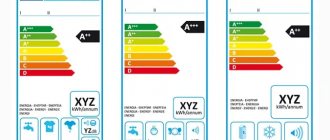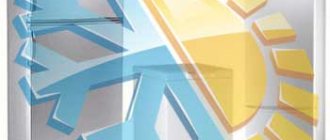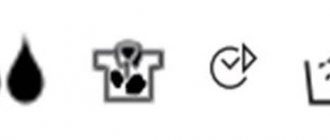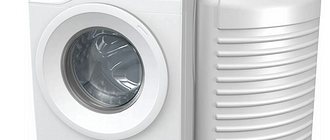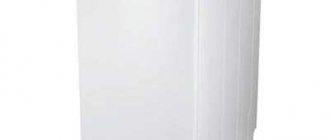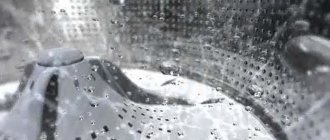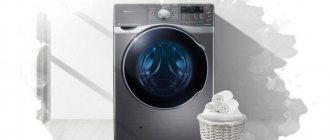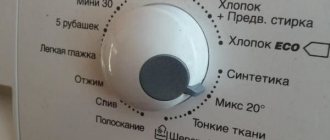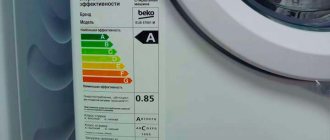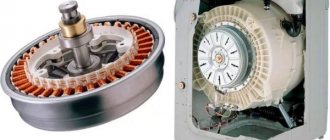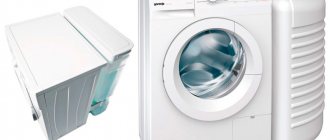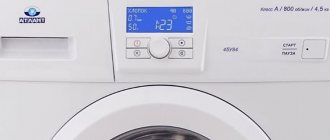European spin standard for washing machines
One of the most important criteria by which the quality of washing machines is assessed, along with the washing class, is the spin class.
It is designated using the letters of the Latin alphabet - A, B, C, D, E, F, G - from highest to lowest. This classification is an accepted European standard and is supported throughout the world. To determine these categories, the device is set to perform a higher or lower number of revolutions per minute: from 400 to 1800. Next, a simple calculation is carried out aimed at calculating the residual moisture of the scrolled laundry. To do this, find the difference in the weight of dry and wet laundry, divide the result by the dry weight and multiply by 100.
The table shows the names of different spin categories of washing machines, what percentage of moisture they remove from the wash during rotation of the drum, and how many revolutions they make per minute:
| A | 55% | 1800 |
| IN | 45% | 1600 |
| WITH | 40% | 1400 |
| D | 30% | 1200 |
| E | 20% | 800 |
| F | 15% | 600 |
| G | 10% | 400 |
The table shows how big the difference is between categories A and G. Things containing 90% moisture can be called very wet: they will dry in the air for a long time.
Modern manufacturers of household appliances now rarely produce models with only spin classes G and F due to their low efficiency.
The letter markings of these categories can be easily found in the instructions for the equipment. However, are models with high centrifuge rotation speeds that good, and whether they will ruin clothes, is another question.
What are the best spin classes for washing machines?
According to the European standard of quality and testing, 7 groups were identified, where it was distributed which class would correspond to a percentage of humidity from 0 to 90%, and the corresponding ability to spin with a drum speed of 400 to 1700 rpm.
Thus, among modern models the following types of spin are distinguished:
- “A” - this letter designates the best class, which achieves the result of almost dry laundry (humidity less than 45 percent).
- “B” - class B is also quite effective and at 1400 rpm it can achieve laundry humidity of up to 54%.
- “C” – class C corresponds to 1200 rpm, and humidity – up to 63%.
- “D” - class D corresponds to a drum rotation speed of 1000-1200 rpm, but the percentage of humidity is equal to a value from 63 to 72%.
- “E” - this spin is available in small-sized machines designed for 800 rpm and spinning to a humidity level of 81%.
- “F” – here the moisture will be from 81 to 90%.
- “G” - this letter corresponds to a spin cycle in which the moisture content will be greater than 90%.
Looking for pros and cons
From the characteristics it is clear that class A allows you to take clothes out of the washing machine almost dry. This is especially convenient when washing thick items, such as jeans, jackets, towels. If you squeeze them poorly, they will be very heavy. Owners of washing machines with a low spin class will have to work hard to remove such things from the drum and hang them up. If physical activity is contraindicated for you, it is better to purchase a model with a high spin class.
Owners of washing machines with a low spin class will have to work hard to remove wet clothes from the drum and hang them up
However, high-end cars are usually significantly more expensive than those in lower classes. Not every consumer can afford such a purchase.
In the future, a “fast” machine may also require increased electricity costs, because it dries things at high speeds. This will make the washing process more expensive. True, now you can choose a model that will allow you to save energy while rotating the drum at the fastest possible speed. Such equipment is marked A++, A+ and A. Next come brands with energy efficiency classes B, C D, E, F, G. But it is now unlikely to find the most energy-intensive models on store shelves: they are already considered obsolete.
Maximum acceleration of the drum can also damage delicate items, such as wool and silk. Due to rapid rotation, the threads wear out, become dull and thin. In addition, with a strong spin, the laundry often becomes very wrinkled, and it can be difficult to smooth it out.
When choosing a spin class, it is worth considering: it is difficult to distinguish the difference between the humidity of items spun at 1000 and 1600 rpm. This is noticeable only when washing clothes made from very thick fabrics. But if you compare 400 and 800 rpm, the difference will be significant. So, at 400, the item will remain completely wet after spinning, and at 800, its humidity will only slightly exceed the air humidity in the room.
Washing machine spin classes
Another important characteristic of a washing machine is the spin cycle. This is one of the key criteria by which modern washing machines are evaluated.
Spin efficiency is also indicated by the English letters A, B, C, D, E, F, G. However, the main indicator when determining spin is not comparison with the standard (as when assigning a washing category), but the residual moisture of the washed laundry. Minimum - 40%, maximum - 90%. Depending on the value of this parameter, the following designations are set:
- A - residual humidity less than 45%, the most effective spin.
- B - laundry is 45-54% damp, good result.
- C - 54-64% moisture remains, normal spin.
- D - 64-71%.
- E - 71-81%, the result is not the best.
- F - humidity 81-90%, low spin.
- G - more than 90%, the laundry is almost wet.
The higher the spin class , the drier the laundry will be after washing. It would seem that you need to choose washing machines of type A, but not everything is so simple , because there are several nuances:
- The higher the class, the more expensive the equipment.
- Maximum spin is necessary, mainly only when washing items made of thick fabrics (jeans, outerwear, terry towels). It can only harm products made of wool, silk and delicate fabrics. They should not be squeezed dry so as not to destroy the structure of the fabric, spoil or tear the product.
- When washing in this mode, the rotation speed of the drum is very high, and the laundry is strongly pressed against the walls of the washing machine. Things will be too wrinkled and it will take a long time to smooth them out.
Types of classes in the machine
Using the standard, a classification of efficiency levels was formed. Washing equipment, like many other types of technological production, are subject to European standards, where a letter grade is relevant. Washing, spinning and energy consumption classes are designated by letters from A to G.
| Designation | Meaning |
| A | Great |
| B | Very good |
| C | Fine |
| D | Fine |
| E | Satisfactorily |
| F | Badly |
| G | Very bad |
These are the options when choosing a washing machine. The first 3 are more often found on sale than others and guarantee acceptable quality of the three indicators.
Washing
Let us specify the classification of washing devices for the process. The level of the machine in comparison with the standard for determining quality must take into account the requirements:
- sameness of fabric;
- washing powder identity;
- coincidence of pollution levels;
- water temperature is 60 degrees Celsius above zero.
This is how the machine washing efficiency class is determined.
Comparison with the standard:
| Grade | Level of quality |
| A | 1,03 |
| B | From 1 to 1.03 |
| C | From 0.97 to 1 |
| D | From 0.94 to 0.97 |
| E | From 0.91 to 0.94 |
| F | From 0.88 to 0.91 |
| G | Less than 0.88 |
When purchasing any item, all the cards can be confused by the overflowing brands. A well-promoted brand does not imply good quality of the product. You can pay a lot of money for a branded Class A washing machine, but an unpromoted company will sell it much cheaper. The quality of the goods in both companies is no different.
We recommend: Washing cotton in a washing machine and by hand
Spin
The labor activity of the device drum affects the percentage of laundry moisture remaining on the laundry at the time of completion. This percentage affects the quality of the spin. It is found by relating the weight of unwashed laundry to the weight of washed laundry.
| Class Rating | Residual humidity, %! | Drum rotation speed, number of revolutions/min. | Spin level | Application of material |
| A | Less than 45 | More than 1500 | Too strong | High density coarse matter |
| B | From 45 to 54 | From 1200 to 1500 | Very strong | Terry |
| C | From 54 to 63 | From 1000 to 1200 | Strong | Rough matter |
| D | From 63 to 72 | From 800 to 1000 | More intense | Synthetic and cotton |
| E | From 72 to 81 | From 600 to 800 | Intensive | Delicate fabrics |
| F | From 81 to 90 | From 400 to 600 | Weak | Thin |
| G | More than 90 | Less than 400 | Very weak | Very thin |
Not all types of fabrics will benefit from the use of grade A equipment. The spin level is strong, therefore, laundry that is weak in density will not withstand it.
- Review of popular laundry capsules
- What should be the composition and effect of a good powder?
- Selecting the correct temperature for the washing mode
The best option would be to use a machine with a class and a number of drum revolutions per minute from 1000 to 1200. In this case, the laundry will not be torn, and you can dry it on a line. With a huge number of revolutions, washing machines jump and vibrate. This is inconvenient and impractical.
Spinning uses centrifugal force. It pushes water out of the fabric. The throughput of the fabric, in addition to the number of revolutions, drum size and spin time, affects the level of dryness of the laundry.
Modern washing equipment is equipped with several spin modes at different speeds.
Energy consumption
Manufacturers of washing machines do not sit still in development. Instead of 7 types of electricity consumption, they invented an economical class, designated A+. The energy consumption of the equipment is less than 0.17 kWh/kg.
For 1 hour at a temperature of 60 degrees Celsius, a kilogram of cotton laundry is placed in the machine and a standard wash is turned on. After the run, the result of the energy spent is revealed.
| Class Rating | Energy consumption level | Electricity consumption, kWh/kg |
| +A | Least | Less than 0.17 |
| A | Small | From 0.17 to 0.19 |
| B | Economical | From 0.19 to 0.23 |
| C | Economical | From 0.23 to 0.27 |
| D | Average | From 0.27 to 0.31 |
| E | High | From 0.31 to 0.35 |
| F | Very tall | From 0.35 to 0.39 |
| G | Too tall | More than 0.39 |
On each model you can find a tag with the name of the class.
Modern machines rarely have B and C. Even cheap washing machines are produced with class A. Engineers have achieved greater savings (A++ and A+++).
About the washing class
To determine the quality of laundry cleaning, the DIN EN 60456/A11-1996 standard has been developed - in accordance with it, 5 kg of sheets, pillowcases, and towels are placed in a drum and run for a full cycle. They dry it in a special chamber and then test it. The reference detergent is manufactured by Hehkel and is available only to washing machine manufacturers. Test samples of fabric with various stains are made in Germany and Switzerland, they are loaded into the drum with the main laundry. The professional washing machine Wascator was adopted as a standard testing apparatus.
Testing the effectiveness of household appliances takes 3 days. The result is analyzed according to 20 indicators, among which the most important is light reflectance. Comparison of samples washed on the tested units is carried out with a standard taken from Wascator (it is taken as 1). The highest degree of quality (A) is an excess of standard whiteness by more than 3%!, the lowest (G) is a deficiency of 12%! or more. In accordance with this, the efficiency class of washing machines of the tested models is assigned:
- A – index greater than 1.03;
- B – from 1.03 to 1.00;
- C – from 0.99 to 0.97;
- D – from 0.96 to 0.94;
- E – 0.93 and 0.92;
- F – from 0.91 to 0.88;
- G – less than 0.88.
Washing classes A and B are the most expensive, category C is not much cheaper. The use of progressive detergents can improve quality .
There is very low demand for cars with the symbols F and G, and some manufacturers refuse to produce vehicles of these classes. It should be noted that the assessment of whiteness is done using an instrumental method: deviations of hundredths of a unit cannot be distinguished by eye.
Explanation and characteristics
Thanks to the letter designation, which can be seen in the characteristics of washing machines, it is possible to obtain complete information about how quickly the drum will work, how much it can dry things after washing and how much energy and time it will consume.
G
The least effective spin class is considered to be “G”, in which up to 90% moisture remains in the washed items. These indicators indicate that the clothes will be dried only 10%! Washing machines with low speeds, within 400 per minute , will not be able to produce better results.
F
The “F” spin class is considered a little more effective, in which things are dried by 80–90%!, which increases the dryness of clothes after the cycle to 10–20%! The speed of washing equipment increases to 600 per minute.
We recommend: Does viscose shrink after washing?
E
The next in the classification is the “E” spin class, in which things have a moisture percentage after drying in the range of 70–81%!, which indicates the dryness of the clothes increases to 20–30%! The power of the machines in this case will almost double compared to the “G” class and reach 800 rpm .
D
Washing units with a spin class “D” are considered more efficient, in which 62–71% of moisture remains in the washed items!, which increases the dryness of clothes to 30–40%!, and this figure is already quite good and can satisfy many consumers who expect on the low cost of equipment and its normal operation.
The speed of drum revolutions in this case increases to a thousand per minute.
C
Class “C” is distinguished by better moisture extraction after washing, the efficiency is already 53–61%!, that is, the machine dries the clothes almost halfway after a full cycle. The unit operates at a speed of 1200 rpm , which is considered an average for high-quality and functional equipment.
B
One of the most productive spin classes is considered to be “B”, in which clothes after washing contain 44–52% moisture, that is, the device allows you to dry them by more than half, significantly reducing the time it takes to completely dry things outside the machine. The revolutions of such equipment also exceed those of class “C”, as they are equal to 1400 per minute .
A
The most effective spin class is considered to be “A”, in which things are dried as much as possible. After washing, clothes contain less than 43% moisture, which is the best indicator for currently existing technology.
The maximum speed that the drum is capable of developing during operation is 1600 rpm, which is the fastest indicator that can help complete work in a minimum amount of time, ensuring maximum efficiency.
European spin standard
Many buyers ask themselves this question: is it worth overpaying for a washing machine with a high number of revolutions, if the laundry is still hung outside, where it dries completely in a few minutes in hot weather? It is better to buy such a high-class machine for people living in cold areas of the country, where drying clothes is problematic, long, and inconvenient. For middle latitudes, you can choose the European standard, which is in the C, D class region.
A high spin class is suitable for regions where there are problems with drying clothes. With this class, things remain wet, but can dry quickly. Classifications F and G are suitable as a low-cost option, used in hot areas where drying clothes will not be a problem. European standards take into account the needs of the population of different countries, and a classification of this level will help facilitate the selection options when purchasing.
For hot regions where there are no problems with drying, machines with spin classes F and G are suitable. Do not forget about the harm that rapid acceleration of the drum system has on thin fabrics. They will not withstand such harsh loads. A few washes in this mode and the items can be thrown away.
Keep in mind that rapid acceleration of the drum may damage delicate items. It is also worth considering that with a strong spin, the material wrinkles strongly and, if there is no appropriate light ironing mode, then this product is difficult to bring into the proper form for wear if it has a strong creasing property.
Also, with a strong spin, things can become very wrinkled. It is worth purchasing models that are at the average level of the rotating capabilities of an automatic washing machine. The 1400 and 1600 spin function may not even be useful. Some SM owners rarely use it for fear of damaging the fabric fibers. Therefore, when choosing this function, you do not need to buy one that has high unit turnover rates, but you should choose a middle-class machine.
Many people rarely use the spin function when washing.
Choosing a washing machine with the optimal spin class
Experts consider the spin class of a machine to be good if the centrifuge is able to remove 40% of the water from the laundry. That is, equipment with the first three categories of rotation A, B and C can be called optimal for washing this or that type of fabric.
Most popular car models can be set to a particular number of revolutions per minute; they often provide a certain range from a lower number to a higher one. This is very convenient, since there are quite delicate fabrics that are not recommended to be subjected to high centrifugal force in a rapidly rotating centrifuge. Below is a table in which different types of fabrics correspond to different centrifuge speeds:
| Cotton, calico, jeans, linen | From 1600 rpm |
| Silk, tulle, satin | 600-800 rpm |
| Wool | No spin |
In addition to varying the number of revolutions, the drum of the machine can also rotate in such a way that the items do not require further ironing. It will be enough to simply hang them carefully to dry and remove the already dry and unwrinkled items.
This mode in different models may be called “no ironing” or “light ironing”.
Meanwhile, there is an opinion that it is possible to achieve quite acceptable quality of spinning things at 1000 rpm. That is, the machine at maximum speeds of 1600 and 1800 rpm can ruin the fabric, and the output of the laundry will be severely wrinkled. Therefore, it is recommended to use the highest rotation speed only when the drum is fully loaded and for washing thick, durable fabrics such as denim.
Spin classes in the washing machine
Any model, one way or another, allows you to remove not just clean, but also practically dry laundry from the machine. In general, the speed of rotation of the drum affects the dryness of things. The characteristic is calculated in this way: the washing and spinning time is divided by the weight of the laundry being washed and multiplied by 100%.
Varieties of spin classes
There are only 7 spin classes and they are designated by Latin letters. At the moment, it is customary for manufacturers to mark only 4 classes - A, B, C and D.
- “A” – the maximum number of revolutions (more than 1000 times) allows you to get almost dry laundry. The humidity doesn't even reach 50%.
- “B” - the drum rotates up to 1000 rpm, while the humidity of things is 54%.
- “C” – the number of revolutions per minute is 800, therefore, the humidity of the washed laundry varies from 55 to 63%.
- “D” – speed – 400, humidity – from 64 to 72%.
Categories “D” and “G” are more typical for older production models. Modern manufacturers have abandoned these categories due to the fact that washed clothes have to be wrung out by hand.
Of course, the speed of the drum and the quality of the dried products are interconnected. For this reason, in machines equipped with categories “A” and “B” the number of revolutions can quite easily fluctuate from 1200 to 2000. A distinctive feature of such models is their impressive dimensions and increased capacity. But the negative side of the process should also be taken into account - the high speed and force with which the laundry is pressed against the walls of the drum are the culprits in the fact that things are too wrinkled.
Every housewife knows that a thing dried due to a large number of turns turns out to be so wrinkled that it requires special moisture before ironing. It turns out that high speeds are not an indicator of high-quality washing. However, the cost of the product also depends on the number of revolutions - such a marketing ploy.
Models that are not particularly wide should be chosen with a minimum number of revolutions - up to 800 and a load of up to 6 kg. The fact is that increased rotation of the drum affects its increased vibration, especially when there is plenty of laundry in the washing machine.
What will European indices tell you?
First of all, you should understand what the spin class in washing machines is. This is considered to be one of the most important parameters for evaluating modern models. It characterizes the percentage of moisture remaining in washed items. This indicator depends on the number of drum revolutions per second - the higher the speed, the drier the things.
We recommend: Is it possible to wash the tent: by hand, in the car, in the bath
To calculate the effectiveness of this process at home, you need to weigh the wrung out laundry, dry it and weigh it again. Then you should make a simple calculation: subtract the weight of the dried laundry from the weight of the wet, divide the result by the weight of the dry items and multiply by 100%!
For example, after washing you weighed the laundry, it turned out to be 5 kg. After drying, its weight decreased to 3 kg. As a result of subtraction, we get the number 2. Divide it by 3 - it comes out to 0.66. We multiply the fraction by 100%! – it turns out that the percentage of humidity is 66%!
Spin efficiency classes
Fortunately, when purchasing equipment in a store, you don’t have to count anything yourself. The spin class of the washing machine is usually indicated in the documentation for the model. It is classified by indices from A to G. This is a European quality standard for drying clothes, which is accepted throughout the world. Each indicator indicates how dry your items will be after finishing washing. Let's take a closer look at the classification:
- G – the percentage of moisture after spinning is above 90%! In such units, the laundry will be only 10% dry at the exit! Number of drum revolutions per minute – 400;
- F – assumes a spin efficiency of 81-90%! at a speed of 600 rpm;
- E – percentage of moisture remaining after washing – 72-81%! The equipment of this class will “scroll” the laundry at a speed of 800 revolutions per minute;
- D – 63-72% moisture will remain in things. Speed – 1000 rpm;
- C – will ensure spin efficiency by 54-63%! In this case, the drum will spin at a speed of 1200 rpm;
- B – the washing machine spins the laundry at a speed of 1400 rpm, leaving no more than 45-54% moisture in it;
- A – provides the driest spin – no more than 45% moisture remains in things. Speed –1600 rpm.
Spin classes
Depending on the speed gained, each machine is assigned a spin class. According to the European standard, the “class list” includes values from “A” to “G”, where the first letter indicates the highest quality of drying, and the last - the lowest. The full gradation is as follows:
- "G". The lowest level at which the percentage of residual moisture reaches 90%, and the maximum spin speed is only 400 revolutions. Due to lack of efficiency, these machines are practically not produced.
- "F". Washing machines of this class spin at 600 rpm, removing moisture from the fabric by a maximum of 20%. Such models are extremely rare.
- "E". Here the drum spins up to a speed of 800 revolutions, which allows you to dry things by 25%.
- "D". The machine reaches up to 1000 revolutions per minute, which as a result allows you to spin clothes by 30%.
- "C". The class is assigned if the equipment spins at 1200 revolutions and the residual humidity does not exceed 60%.
- "B". The maximum spin is 1400 rpm, which ultimately pushes out up to 45% of moisture from the fibers.
- "A". The most effective spin, which dries the fabric almost completely. About 55% of moisture is removed, as a speed of 1600-1800 rpm is achieved.
The spin level must be indicated on the label of each washing equipment. But this characteristic greatly affects the cost of the machine: you will have to pay extra for an increased level.
How to choose the right machine according to these characteristics
An expensive thing does not mean the best, but from the cheap ones you can choose an option in which you have the opportunity to win. Production focuses on budget options.
An automatic washing machine of class A may lose the quality of spin class B and C. The difference is that the rotation speed of the drum is too high, and it can damage the laundry.
The machine selection scheme is simple:
- family budget analysis;
- selection of washing and spin classes for washing machines (optimality corresponds to B and C);
- selecting the type of energy consumption (from A+ and above);
- selection of drum diameter (depending on the calculation of the amount of dirty material per cleaning).
Any washing machine has advantages and disadvantages when it comes to the versatility of the equipment. A household machine of any class is designed for a specific type of laundry (fragile, rough, dense, delicate, etc.).
Relationship between classifications and energy consumption
Often the decisive factor when choosing a washing machine model is the energy consumption class. If the quality of cleaning clothes practically does not depend on the amount of electricity consumed, then the degree of spin is directly related to this indicator. The dependence is determined by the number of drum revolutions: high speed requires increased consumption of kilowatt-hours.
Therefore, when choosing the best option in terms of price-quality ratio, spin classes and energy consumption are of decisive importance. It is obvious that high-class spinning machines are not at the peak in terms of energy efficiency. As for the scale of specific consumption of kilowatt-hours, it, just like the two stickers discussed above for the quality of washing and the spin class in machines, is represented by a letter series from A to G. The difference is the existence in the upper part of subclasses A+ and A++ .
Impact of class on energy consumption
Another criterion for choosing a washing machine is energy efficiency. This concept is closely related to the spin class, so the higher the number of revolutions, the more energy the equipment consumes during its operation.
We recommend: How to wash roller blinds, how to remove stains and not damage the fabric?
Modern models of washing machines have the following classification according to energy efficiency criteria:
- A is the best option, allowing you to save up to 80% energy. There are several subclasses in this class: A+, A++, A+++ (the more “+”, the greater the savings).
- B – allows you to save up to 50% of electricity. Quite an interesting option in terms of the combination of price and quality.
- C – guarantees efficient operation with energy savings of 25%.
- E - refers to inefficient types of equipment, allowing you to save only 10% of energy.
- F – washing machines, which consume 10% more energy than any other equipment;
- G is the champion in the inefficiency category, consuming 25% more electricity than other machines.
In addition to the spin class and energy consumption, when choosing a washing machine you need to pay attention to the washing class, otherwise there is a risk of getting well-wrung but not clean enough clothes.
Expert advice
If the question arises about choosing a new washing machine, you should not only trust your feelings, but also listen to the advice of experts.
- It is recommended to buy certified products from well-known German, Italian, Japanese brands, the quality of which has been tested over the years.
- When choosing a machine, you need to look not only at the spin class, but also at energy efficiency , which can differ several times between different models. It is best to buy products marked A+++, A++, A+ or A, but not lower.
- Vertical models are subject to greater fluctuations and vibrations during the washing process than horizontal washing machines.
Having received all the necessary knowledge, you can safely choose washing household appliances that will serve for many years, providing high-quality and reliable operation.
